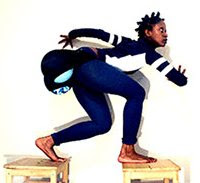This evening at Transformer
Today, Thursday, September 27, from 6:30 - 8pm, DC's Transformer has Holly Bass in "Pay Purview."
Pay Purview is an ongoing multidisciplinary work combining live performance with original recorded music and video. Pay Purview is an exploration of the role of women in commercial hip hop music and videos.Details here.
In the live performance for Transformer, Holly Bass wears a "booty ball" costume piece made of playground balls to create an exaggerated, oversized, Hottentot-style derriere. Presented in Transformer's storefront window space, the audience, participating from the sidewalk outside the gallery, is asked to pay a dime for each viewing. A curtain opens for a short time and the performer dances to a selection of songs ranging from Rodgers & Hart's "Ten Cents a Dance" to Sir Mix-A-Lot's "Baby Got Back." The dance scenes range from mock burlesque to video-ho-booty-shaking to ethnographic display depending on the selected tune and the performer's impulse.


